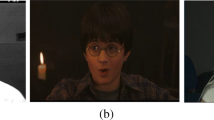Abstract
The use of social networks has grown exponentially in recent years. The large amount of data available in these networks can be effectively utilized in many machine learning applications. This paper proposes a framework of an emotion recognition system that fetches huge amount of face images from the social networks into a cloud. In the cloud, the problem of the unlabeled facial images is handled by applying an active learning approach. For the feature extraction, an interlaced derivative pattern is used, while for a base classifier, an extreme learning machine is utilized. Once the emotion is recognized in the cloud, it can be shared with the end users to meet their interests. Several experiments were performed using some publicly available databases and heterogeneous images from the social networks. Experimental results showed that the proposed framework may effectively be used in the emotion recognition.






Similar content being viewed by others
References
Averbeck BB, Bobina T, Evansa S, Shergill SS (2012) Emotion recognition and oxytocin in patients with schizophrenia. Psychol Med 42(02):259–266
Bettadapura V (2012) Face expression recognition and analysis: the state of the art. College of Computing, Georgia Institute of Technology. Available at: http://arxiv.org/ftp/arxiv/papers/1203/1203.6722.pdf
Domes G, Kumbier E, Heinrichs M, Herpertz SC (2014) Oxytocin promotes facial emotion recognition and Amygdala reactivity in adults with Asperger syndrome. Neuropsychopharmacology 39:698–706
Fang Q, Xu C, Sang J, Hossain MS, Muhammad G (2015) Word-of-mouth understanding: entity-centric multimodal aspect opinion mining in social media. IEEE Trans Multimed 17(12):2281–2296
Freytag A, Rodner E, Bodesheim P, Denzler J (2013) Labeling examples that matter: relevance-based active learning with Gaussian processes. Proc GCPR, 282–291
Fu Y, Li B, Zhu X, Zhang C (2014) Active learning without knowing individual instance labels: a pairwise label homogeneity query approach. IEEE Trans Knowl Data Eng 26(4):808–822
Haque MM, Holder LB, Skinner MK, Cook DJ (2013) Generalized query-based active learning to identify differentially methylated regions in DNA. IEEE/ACM Trans Comput Biol Bioinf 10(3):632–644
Hossain MS, Muhammad G (2015) Audio-visual emotion recognition using multi-directional regression and Ridgelet transform. J Multimodal User Interf
Hossain MS, Muhammad G, Alhamid MF, Song B, Al-Mutib K (2016) Audio-visual emotion recognition using big data towards 5G. Mob Netw Appl. doi:10.1007/s11036-016-0685-9
Hossain MS, Muhammad G, Song B, Hassan M, Alelaiwi A, Alamri A (2015) Audio-visual emotion-aware cloud gaming framework. IEEE Trans Circuits Syst Video Technol 25(12):2105–2118
Huang G-B, Zhou H, Ding X, Zhang R (2012) Extreme learning machine for regression and multiclass classification. IEEE Trans Syst Man Cybern B Cybern 42(2):513–529
Jiang D, Cui Y, Zhang X, Fan P, Ganzalez I, Sahli H (2010) Audio visual emotion recognition based on triple-stream dynamic bayesian network models. In: D’Mello S, et al LNCS 6974, p 609–618
Kanade T, Cohn J, Tian Y (2000) Comprehensive database for facial expression analysis. Proc. IEEE international conference on face and gesture recognition, 46–53
Lawrence K, Ruth C, Skuse D (2015) Age, gender, and puberty influence the development of facial emotion recognition. Front Psychol 6:761
Liu K-H, Xu C-G (2009) A genetic programming-based approach to the classification of multiclass microarray datasets. Bioinformatics 25(3):331–337
Majumder A, Behera L, Subramanian VK (2014) Emotion recognition from geometric facial features using self-organizing map. Pattern Recogn 47(3):1282–1293
Mansoorizadeh M, Charkari NM (2010) Multimodal information fusion application to human emotion recognition from face and speech. Multimed Tools Appl 49(2):277–297
Martin O, Kotsia I, Macq B, Pitas I (2006) The eNTERFACE’05 audiovisual emotion database. Proc. ICDEW’2006, 8, Atlanta, GA
Muhammad G (2015) Automatic speech recognition using interlaced derivative pattern for cloud based healthcare system. Clust Comput 18(2):795–802
Muhammad G, Melhem M (2014) Pathological voice detection and binary classification using MPEG-7 audio features. Biomed Signal Process Control 11:1–9. doi:10.1016/j.bspc.2014.02.001
Qian S, Zhang T, Xu C, Hossain MS (2015) Social event classification via boosted multi-modal supervised latent Dirichlet allocation. ACM Trans Multimedia Comput Commun Appl (ACM TOMM.) 11(2) Article 1, Article. 27: 27.1–27.22
Sachse M, Schlitt S, Hainz D, Ciaramidaro A, Walter H, Poustka F, Bölte S, Freitag CM (2014) Facial emotion recognition in paranoid schizophrenia and autism spectrum disorder. Schizophr Res 159(2–3):509–514
Senechal T, Rapp V, Salam H, Seguier R, Bailly K, Prevost L (2012) Facial action recognition combining heterogeneous features via Multikernel learning. IEEE Trans Syst Man Cybern B Cybern 42(4):993–1005
Shobeirinejad A, Gao Y (2010) Gender classification using interlaced derivative patterns. Proceedings of the 20th International Conference on Pattern Recognition (ICPR), 1509–1512
Sourati J, Erdogmus D, Dy JG, Brooks DH (2013) Accelerated learning-based interactive image segmentation using Pairwise constraints. IEEE Trans Image Process 23(7):3057–3070
Viola P, Jones M (2004) Robust real-time face detection. Int J Comput Vis 57(2):137–154
Yang X, Zhang T, Xu C, Hossain MS (2015) Automatic visual concept learning for social event understanding. IEEE Trans Multimed 17(3):46–58
Acknowledgments
The authors extend their appreciation to the Deanship of Scientific Research at King Saud University, Riyadh, Saudi Arabia for funding this work through the research group project no. RGP-1436-023
Author information
Authors and Affiliations
Corresponding author
Rights and permissions
About this article
Cite this article
Muhammad, G., Alhamid, M.F. User emotion recognition from a larger pool of social network data using active learning. Multimed Tools Appl 76, 10881–10892 (2017). https://doi.org/10.1007/s11042-016-3912-2
Received:
Revised:
Accepted:
Published:
Issue Date:
DOI: https://doi.org/10.1007/s11042-016-3912-2




